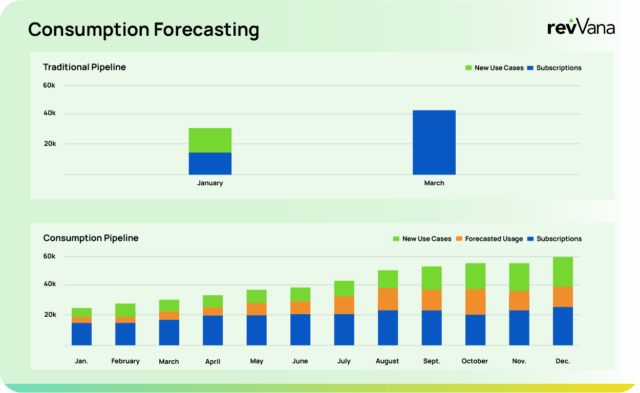As businesses move deeper into the world of usage-based pricing, one of the most transformative changes is the shift in how revenue is forecasted. Gone are the days when revenue was purely driven by upfront contracts and renewals. In today’s environment, a significant portion of revenue comes from the ongoing consumption of products and services, which grows over time, especially through expansions.
In a usage-based model, forecasting doesn’t just stop after the initial deal closes. Expansions become a primary growth driver. However, this new revenue dynamic requires a different way of thinking and forecasting. Managing expansions effectively hinges on a more nuanced approach, understanding customer behavior, and leveraging real-time data to predict future usage and opportunities.
Understanding Expansions in the Context of Consumption
In usage-based pricing, expansions refer to the increase in product usage, often by existing customers, over the course of their journey. This can include customers adopting new features, adding new users, or scaling their usage to meet growing business needs. Unlike traditional models where upsells and cross-sells were often separate from usage, in consumption-based models, expansions are fundamentally tied to how a customer interacts with your product on an ongoing basis.
Here’s the catch: Unlike renewals, which are somewhat predictable based on contract terms, expansions are influenced by dynamic usage patterns. Therefore, businesses need to understand when and why customers expand their usage, not just when they’re expected to renew.
What Makes Expansions So Challenging to Forecast?
Expansions are more unpredictable than renewals. Predicting when a customer will expand their usage isn’t as straightforward as tracking contract dates. Several factors contribute to the complexity of forecasting expansions:
- Shifting Usage Patterns: Customer needs evolve over time. A feature that may not have been essential at the start could become critical as the customer scales their operations. These changes can be gradual and often don’t follow a predictable timeline.
- Varied Customer Behavior: Every customer engages with your product differently. Some may adopt features quickly, while others may take a more conservative approach, expanding only when they hit specific milestones or when their business needs shift.
- Market and Environmental Factors: Changes in the industry or external market forces, such as a sudden surge in demand for a product category, can accelerate usage in ways that are difficult to forecast.
Best Practices for Managing and Forecasting Expansions
While forecasting expansions can feel like navigating through shifting sands, there are clear steps businesses can take to improve accuracy and drive growth.
- Capture Real-Time Usage Data
To forecast expansions effectively, it’s crucial to have access to real-time usage data. This data is the backbone of any forecasting model for expansions, allowing teams to understand how customers are engaging with the product and how their usage is evolving over time. The key is to continuously monitor usage patterns so you can anticipate shifts that might indicate an expansion opportunity.
- Develop Flexible Forecasting Models
Unlike the rigidity of traditional forecasting models, expansion forecasting needs flexibility. You can’t assume that every customer will expand in the same way or at the same rate. Instead, create models that can adapt to different growth trajectories. Use historical data, but adjust your forecast to allow for customer-specific variables that influence growth.
- Collaborate Across Teams for Greater Insight
Sales and customer success teams are on the front lines, closely interacting with customers and understanding their needs. Their input is essential in identifying potential expansion opportunities. Integrating insights from these teams into your forecasting models ensures that you’re not just relying on data but also on the valuable context they provide.
- Utilize AI to Predict Expansion Trends
AI is becoming indispensable in the world of consumption forecasting. By analyzing historical usage data, AI can identify patterns and predict when customers are most likely to expand. Whether it’s identifying the right time to upsell or catching early signs of churn before they impact revenue, AI can provide a level of foresight that traditional methods can’t match.
- Segment Your Customers Based on Usage Patterns
Not all expansions are created equal. Some customers may have a higher potential for growth, while others may be more conservative in their consumption. Segmenting customers based on their usage patterns and growth potential allows you to tailor your forecasting approach. For example, enterprise customers may show different expansion trajectories than smaller, mid-market clients.
- Integrate Feedback Loops to Fine-Tune Forecasts
Regularly revisiting and updating your expansion forecasts based on customer feedback ensures that your models stay relevant. By capturing feedback from customer-facing teams—whether through surveys, meetings, or direct conversations—you can get a more accurate sense of where expansions are likely to occur. This human touch, combined with real-time data, leads to more accurate and actionable forecasts.

How revVana Helps with Expansion Forecasting
At revVana, we understand that managing and forecasting expansions is no easy feat. That’s why we provide businesses with the tools to capture real-time data and automate forecasting processes. By integrating customer sentiment, usage patterns, and AI-driven insights, revVana helps businesses continuously monitor and predict expansions.
revVana’s forecasting engine helps track both current and potential expansions in a customer’s lifecycle. Our solution automates the process, so businesses don’t need to manually recalculate forecasts each time a new opportunity arises. Whether it’s tracking increased usage or identifying upsell opportunities, our platform ensures your expansion efforts are always aligned with real-time data.
By leveraging revVana’s automated, real-time forecasting capabilities, businesses can more effectively capture expansions, enabling sales and customer success teams to focus on driving that growth.
In usage-based pricing, expansions aren’t just another metric, they are essential for long-term growth. The challenge lies in anticipating when these expansions will happen and understanding the factors that drive them. By leveraging a combination of real-time data, AI, and team insights, businesses can forecast expansions with more confidence and precision.
At revVana, we help businesses turn expansion forecasting from a guessing game into a strategic advantage. With the right tools and insights, your team can stay ahead of customer needs and capitalize on every opportunity for growth.






